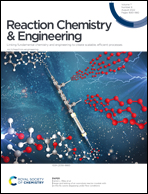CO2 fixation into cyclic carbonates catalyzed by single-site aprotic organocatalysts†
Abstract
CO2 fixation is a prominent research theme that attracts the attention of scientists, stakeholders and governmental entities with the aim of ultimately bringing commercial products to the market. Herein, a series of mono-, bi-functional and polymeric imidazolium-based catalysts were synthesized and utilized for the production of cyclic carbonates (CCs) using epoxides and 1 bar of CO2 under mild reaction conditions. In addition, three onium salts, namely, ammonium, phosphonium, and pyridinium, were synthesized and characterized using 1H/13C nuclear magnetic resonance (NMR) and attenuated total reflectance-Fourier transform infrared (ATR-FTIR) spectroscopies, together with thermal gravimetric analysis (TGA), high-resolution mass spectrometry (HRMS) and elemental analysis (EA). All the investigated organocatalysts showed almost quantitative CC conversions, which were isolated from the crude reaction and identified spectroscopically. Density functional theory (DFT) calculations revealed that the aforementioned onium salts followed the same detailed mechanism for the cycloaddition reaction, which started with the electrostatic interaction of the onium centers with the oxygen atom of the epoxide. Even in the case of the imidazolium nucleus, the acidic C2 proton played a marginal role in the epoxide activation than in the ring-opening step.



 Please wait while we load your content...
Please wait while we load your content...